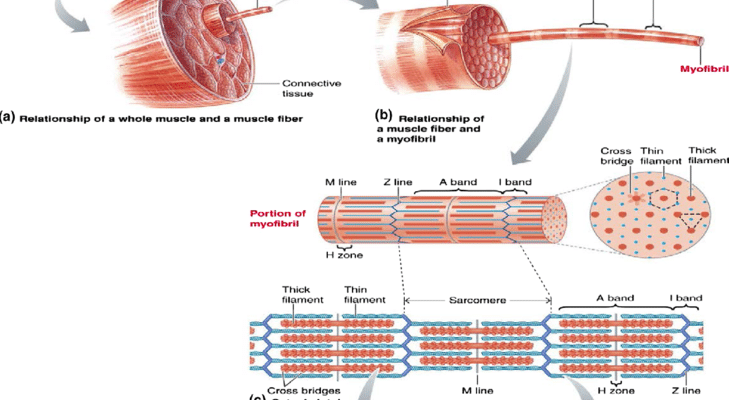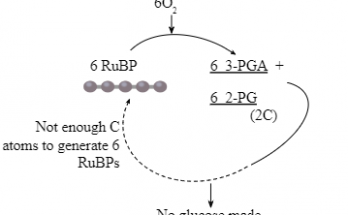Table of Contents
What are Striated Muscles
Striated muscles are muscles that are attached to bones and are responsible for voluntary movement.They have a striped or banded appearance due to the presence of repeating units of muscle fibers called sarcomeres.Sarcomere is composed of contractile protein filaments (myofilaments) that include mainly the thick filaments called myosin, and thin filaments called actin. The bundles of myofilaments are called myofibrils.Striated muscles are under voluntary control that means they are controlled by the somatic nervous system and are responsible for actions such as walking, running, and lifting weights.
Striated muscles are composed of long, cylindrical cells called muscle fibers, which are lined up parallel to each other and are able to contract and relax in response to nerve impulses.
Striated muscles are also known for their high endurance and fast contraction times.Striated muscles are responsible for movement, posture, and support of the body. Examples of striated muscles include the biceps, triceps, and quadricep.Striated muscles are also known for their high endurance and fast contraction times.
Where are striated muscles found in ?
- Striated muscles are found throughout the body and are responsible for movement and posture. They are attached to the bones by tendons and are controlled by the nervous system.
- Striated muscles are found is in the limbs arms and legs . They are responsible for moving the joints and performing tasks such as lifting, pushing, and pulling. Striated muscles are also responsible for maintaining posture and balance.
- Striated muscles are also found in the trunk of the body. The striated muscles of the back and core are responsible for maintaining an upright posture and supporting the spine.
- Striated muscles can also be found in smaller areas of the body such as the face, neck, and even the tongue. These smaller muscles are responsible for controlling facial expressions, swallowing, and speech.
Types of Striated Muscles
Types of striated muscles work together to help the body move and function properly. The different types of Striated Muscle have unique properties and functions that are specific to their location and role in the body.
- Skeletal muscle
Skeletal muscles are the type of Striated Muscles that are attached to the bones. They are responsible for movement of the body and are under voluntary control. These muscles are responsible for movement and are typically found in the limbs, neck, and torso. They are composed of muscle fibers that are arranged in parallel and are surrounded by tendons. Skeletal muscles are also called striated muscles because of the visible bands or stripes that run across the fibers.
- Cardiac muscle
Cardiac muscle is the muscle found in the heart and is responsible for pumping blood throughout the body. These muscles are also striated and are composed of muscle fibers that are arranged in a branching pattern. The fibers are also surrounded by connective tissue, which helps to keep the heart in shape. Cardiac muscle fibers are also rich in mitochondria, which are responsible for generating energy for the heart to function.
Cardiac muscle is also involuntary which means it contracts automatically and cannot be controlled voluntarily.
Structure of Striated Muscles

Striated muscle cells are elongated cells. They are called striated because of the alternating light and dark bands that can be seen when the muscle is viewed under a microscope. These bands are called sarcomeres; they are the basic unit of muscle contraction.
- Striated muscle cells are composed of many myofibrils they are long, cylindrical structures made up of contractile proteins.
- Each myofibril is made up of repeating units called sarcomeres, which contain the proteins actin and myosin.
- The sarcomeres are arranged in a specific pattern, with the actin and myosin proteins forming a repeating pattern of light and dark bands.
- The cell membrane which surrounds each muscle fiber and is responsible for transmitting electrical signals that trigger muscle contraction.
13 Important Characteristics of Striated muscles
Characteristics of STriated muscles are as follows –
- Striated muscle cells have the ability to contract and relax, allowing for movement and muscle tone.
- High endurance- Striated muscles have a high endurance capacity which allows them to perform repetitive contractions for long periods of time.They contain myofibrils, which are composed of actin and myosin filaments that slide past each other to generate muscle contraction.
- Multinucleated – Striated muscles contain multiple nuclei in every muscle cell, which allows them to generate more force and endurance.
- Cross-striations – Striated muscles have a cross-striated appearance, which is caused by the presence of actin and myosin filaments that interact to cause muscle contraction.
- Fast contraction – Striated muscles are capable of fast contractions, which allow for quick and powerful movements.
- Involuntary control – Some striated muscles are under involuntary control like the heart muscle.
- Force generation – Striated muscles generate a strong force when contracted, which allows for heavy lifting and other demanding tasks.
- Rich blood supply- Striated muscles are rich in blood supply, allowing for efficient delivery of oxygen and nutrients to the muscle cells.
- Striated muscles are capable of hypertrophy, or growth in size and strength, in response to regular exercise.
- Adaptability to changes – Striated muscles can adapt to changes in activity levels, such as increased strength and endurance with regular exercise.
- Skeletal muscle – Striated muscles are mostly found in the skeletal system . They are responsible for moving bones and joints.
- Voluntary control – Striated muscles are under voluntary control, meaning that an individual can consciously control the contraction and relaxation of these muscles.
- Fast fatigue – Striated muscle fibers can fatigue quickly, especially when they are subjected to intense or prolonged contractions.
Also Check – Differentiate between Bone and Cartilage with respect to Structure Functions and Location.
11 Important Functions of Striated Muscles
- Movement of Body
Striated muscles are responsible for the movement of the body which includes walking, running, jumping, and other forms of physical activity. They are also responsible for controlling the movement of the limbs and other body parts.
- Posture of the body
Striated muscles help to maintain posture and balance by contracting and relaxing in response to changes in the body’s position. This allows the body to stay upright and maintain proper alignment.
- Assist in process of Breathing
The diaphragm, a striated muscle located in the chest, plays a key role in breathing by contracting and relaxing to expand and contract the lungs.
- Heart Function
The heart is made up of striated muscle tissue. It contracts to pump blood throughout the body.
- Digestion
Striated muscles in the stomach and intestines contract and relax to aid in the process of digestion and help move food through the digestive tract.
- Metabolism
Striated muscles play an important role in metabolism by providing energy for movement and physical activity.
- Force production –
Striated muscles can produce large amounts of force, which is important for activities like lifting heavy objects or performing physical labor.
- Speech
Striated muscles in the face and throat play an important role for controlling the movement of the lips, tongue, and vocal cords to produce speech.
- Sexual function
Striated muscles in the pelvic region play an important role in sexual function which include erection and ejaculation.
- Facial expressions
Striated muscles in the face are important to control facial expressions and allow for changes in the shape and position of the mouth, eyes, and other facial features.
- Movement of joints
Striated muscles, also known as skeletal muscles, play a crucial role in the movement of joints. They attach to bones via tendons and contract to produce force, which results in movement at the joint. The contraction of opposing muscle groups can also help to control and stabilize a joint during movement.
Did you find this article helpful? We’d love to hear your thoughts and suggestions in the comments!
Frequently asked Questions on this topic
What are Striated Muscles?
What gives Striated Muscles their striped appearance?
What are sarcomeres, and what are they composed of?
How are Striated Muscles controlled?
Where are Striated Muscles found in the body?
What are the different types of Striated Muscles and what are their functions?
What is skeletal muscle and where is it typically found?
What is cardiac muscle and where is it found?
What is the structure of Striated Muscles?
What are the important characteristics of Striated Muscles?
What is muscle hypertrophy?
Are Striated Muscles under voluntary or involuntary control?
What is the role of Striated Muscles in posture and movement?


7 Comments on “Striated Muscles – Definition , Structure, Types , Functions”